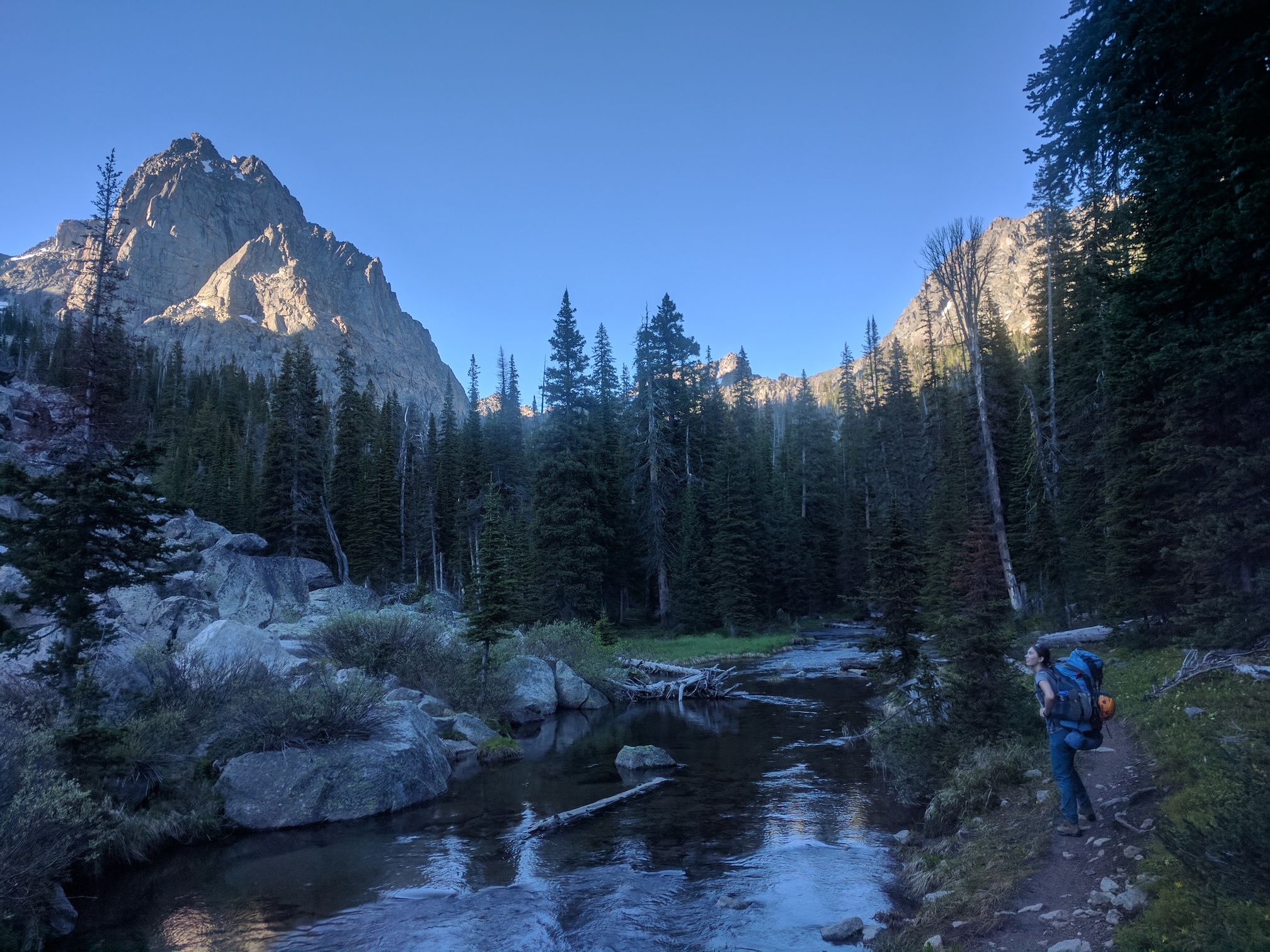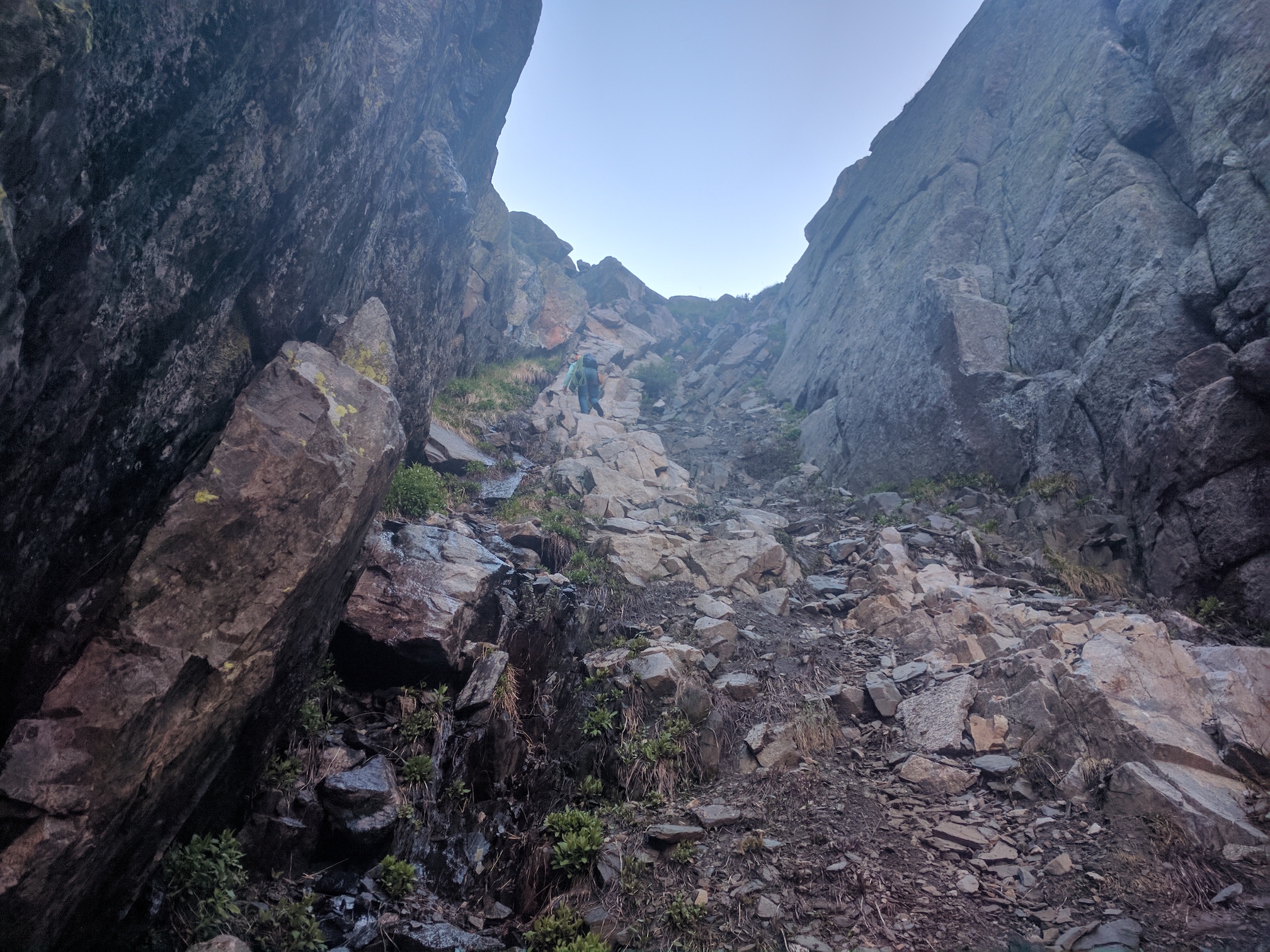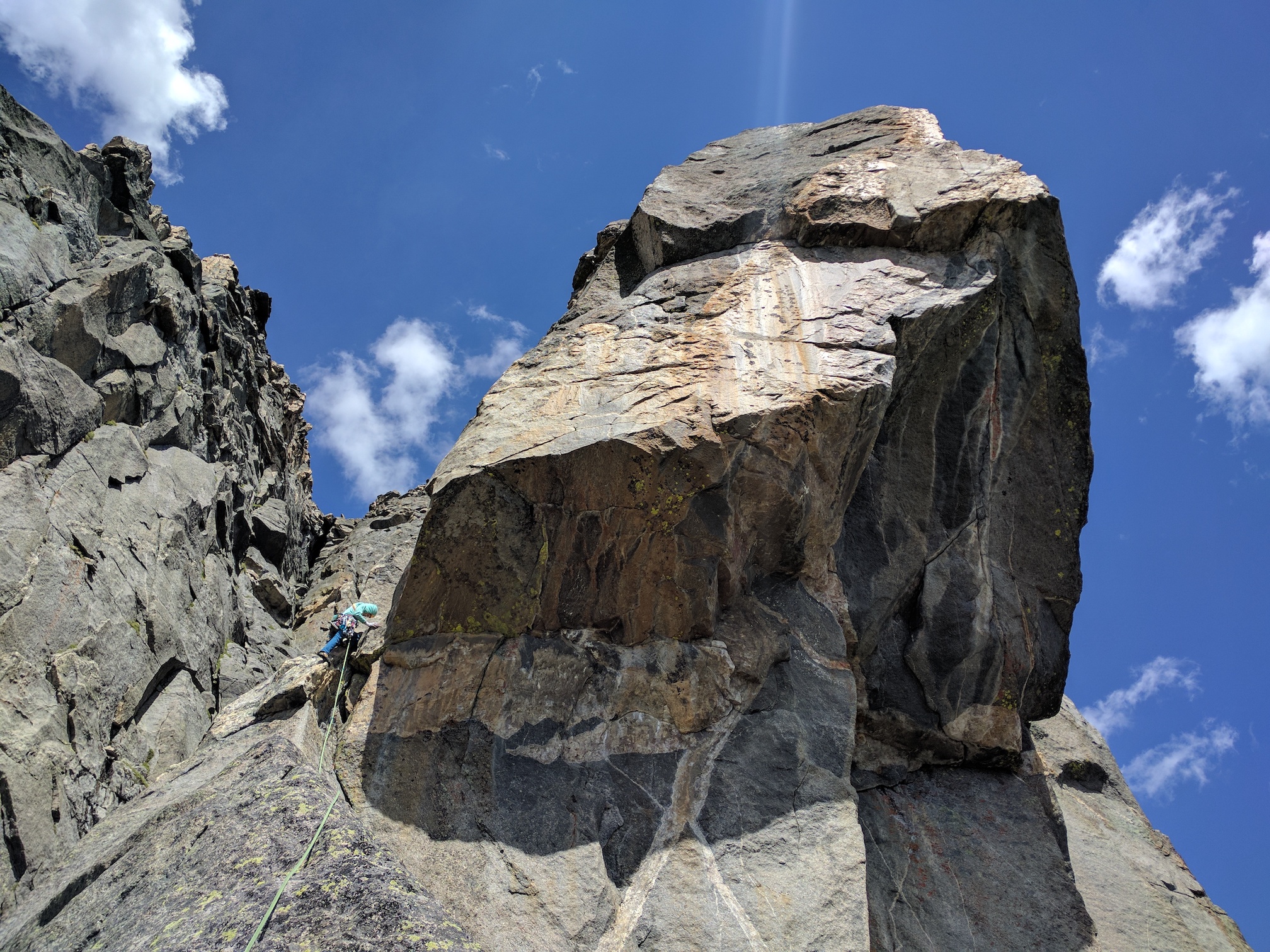Mixed Messages on the Montana Centennial Route
Or alternatively, there’s good at climbing, and there’s good at climbing.

4:30am on July 1st, Elena’s wristwatch alarm was beeping gently away. Outside the Eenie Buttress of Mt. Cowen was just a shadow against the still dim, early morning sky. Elbow lake rippled silently beneath the massif.

The Montana Centennial Route would be our most ambitious objective yet, clocking in at around 11 pitches, most of which were at least 5.10 in difficulty and around 50-60m in length. I was especially anxious about the few comments we found on the 5.11a crux pitch: tricky pro, and more like 11b. I wasn’t sure if I was solid leading at that level yet, and I was worried too, about Elena’s ability to follow it with three liters of water on her back and the double rack of cams (through #4) that we brought swinging from her shoulder. Our last big route, Inti Watana - Resolution Arete had more climbing (~21 pitches) but also featured several bolted anchors and cruiser face climbing on edges and easy features. I was glad we had hiked in the nine miles from the trailhead the night before, giving us the entire day to climb.

From our campsite the approach followed a creek through boulder fields trees, eventually up a shallow gully and found us at the base of the route around 45 minutes later. The first pitch at 5.8 felt very much like an approach pitch - a little dirty, a little wet, a little tricky to routefind, but after a couple of false starts we were on our way. A few wet slab moves later and we were at the base of one of the most memorable pitches on the route: pitch four’s sixty meter 5.9 corner. Elena took the lead on this monster, and following it I found everything from wildly enjoyable 5.8 to carefully thoughtful 5.9 stemming.

About an hour later we were looking up at the hand crack that led into the .11a/b crux pitch. Our topo made note of a 5.10+ “hand and fist traverse” in the first half. I could see it all too clearly, thanks to the dark streaks caused by the veritable river that was flowing out of it. I took a few deep breaths and closed my eyes, savoring the alpine air and trying to both acknowledge and ignore the mounting pressure I felt inside.
The initial hand crack was thin, #0.75 camalot size, but the feet were solid and soon I was pulling on perfect #1 jams before I felt a sudden, sharp cramp. I froze, mostly because I was having a hard time moving any part of my right arm at all, but also because this was possibly the very worst time to be tired or injured. We weren’t even halfway done. I had to lead a lot of harder stuff today - with a dark laugh I also realized that if anything it would just be embarrasing if I had to take now! Besides, my last piece was about ten feet below me - I couldn’t take even if I wanted to. I would have to face the fall.
My left hand went in, my right hand came out. Opening it, closing it, I slowly regained movement in my fingers. I placed a piece, and climbed on. As I approached the flowing traverse crack I was pleasantly surprised to find locker jams, solid despite the wetness, and just enough dry feet that I was able to squeak through by way of an exhilerating, bouldery cross-over sequence. I stood on that rest ledge for what felt like ten minutes, slowly rubbing out the last of the stiffness from my forearms. I took a slow breath and stepped back onto the face. Somehow I pulled through the thin layback crux and suddenly, with smiles on our faces, we were on top of the pitch.

A few hours went by of amazing positions, wild 5.9 hand traverses, steep, strenuous hand cracks, and pleasant finger cracks(as well as a lost approach shoe and water bottle!) and there was only one pitch left to go - the bookend companion to the first pitch, a wandering 5.7 line through less than ideal rock. It was starting to get late too, the fatigue, our enthusiasm for the climbing and the seemingly boundless sunny weather tempering our usually sharp belay turnarounds. Rainclouds were forming in the distance.

An hour passed, and I was still on lead, twenty feet from the belay. There were about six different lines that looked likely, some more than others, and some twisting and turning into each other. Our topo pointed to a left trending line over easy scrambling ground, but the line I had found seemed like it was too short to match the supposedly 50m pitch length. Besides, the section following it looked far too steep to be reasonably graded 5.7. I grew desperate, trying every more unlikely and runout variations around the right, before inevitably giving up and retreating. It had begun to rain, and I only had a down jacket and a light wool baselayer on. Elena stood, belaying patiently, but I at least was growing more and more nervy. Looking up, the rock seemed impossibly steep, loose, and blank, it looked cold and intimidating, impossible to climb. Just a few hours earlier and I was calmly working through 5.11 crack cruxes and now I was paralyzed, less than a ropelength from the summit, unsure of where to go or what to do.
I pulled out the topo again, this time noticing the small words printed near the top of the pitch: “5.9 bulge.” Evidently the topo author disagreed with the guidebook’s 5.7 grade designation. I thought about the headwall I dismissed as too difficult terrain to be the correct line and cursed under my breath. Much to my simultaneous chagrin and relief I found myself punching through to the summit minutes later. Elena joined me shortly after, the rain had stayed light and intermittent, and I could see the rocky rib to our right that we were aiming for to find the rappel anchors. I thought to myself that at least we would be down and finished soon enough.
Hm.
Nervous about the potential for slipping on the 2nd and 3rd class grassy slopes we decided to simul the ~500’ traverse across the grassy bowl and over the rocky rib to our right. Inspiring gear was hard to come by however, and the rope drag was unbearable. We were moving slowly, and it wasn’t at all clear where the rappel anchor was supposed to be. Eventually, I spotted it - behind us.
An audible breath of relief escaped my lips as we pulled the rope off the second rappel. At this point we had only a gully descent before we were back at camp - a previous report we had read pegged the descent at around 40 minutes. We figured it would actually take a lot longer than that - and given that it was already past nine in the evening, that meant hiking some in the dark. Still, I was optimistic - the base of Eenie was basically all talus anyway so I figured it was going to be pretty difficult to get lost.
We started down the east gully, pleasantly surprised by the ease of navigating over the scree and boulders in our path. I knew we wanted to curve around to the west to get to our campsite, so we took every opportunity to curve around to the south and west as we descended. As darkness fell we began to slow - Elena was wearing my TC pro on one foot in lieu of her lost approach shoe and we only had one headlamp between the two of us. Small cliffs on our left drove us further to skier’s right and further southwest across what I thought was talus - but after a coule hours of bushwacking we realized we were trapped on an intermediate cliff system with no way to access the talus field beneath us. Water and morale was running low - in desperation we rigged a rappel off a large block wedged across a chimney and prayed the rope would reach the ground. Of course, it didn’t quite, but after short scramble and a moderate hike we were at the upper lake, purifying water and eating the last of our food reserves. It felt good to be on solid ground, once again.
Still, it wasn’t until a couple hours later that we found ourselves even with Elbow Lake. At this point it was well past midnight, and fatigue was messing with my ability to visualize the terrain, no doubt causing Elena some frustration. 2:00AM and we rolled into camp, completely worked. We ate the most glorious instant Indian I have ever had, and proceeded to sleep so soundly we awoke only to the blasting hot rays of the 10AM alpine sun.
What a climb.


BETA
We primarily used the Mountain Project entry as well as the Bozeman area climbing guidebook for beta. Most of it is quite adequate, though I’ll supply some of our own first hand points here:
Gear: Double set of cams from Metolius #1 to BD #4, I also brought a Metolius #0. Full set of nuts (we brought two sets but I think one is adequate - maybe double up on medium size nuts if you like), 8-10 alpine draws, 2-3 double alpine draws, 4-6 regular draws, long slings for anchors and emergency rappels, ha.
Approach As described on MP/guidebook. Since you can see the route from camp it’s hard to mess up too badly. There was a cairn at the start of the route as of 2017-06-01
Pitch 1: 5.8, ~40m. Start up the corner system bear left onto a large ledge and choose your own adventure up the face. MP suggests bearing right to follow a moderate crack although I was unable to find it. This pitch ends on a large grassy ledge system. It is suggested to link this pitch into the next (requires a short amount of simuling) but I found the rope drag to be too bad for this to be feasible. However, this is also probably because I went slightly off route, so YMMV.
Pitch 2: 5.7 ~35m. Start up the slab (many fun, slightly harder than 5.7 options available) and continue up large steps to a large ledge system. It might be possible to traverse climber’s right to the start of the 3rd pitch but I chose to belay here.
Pitch 2.5: 2nd class, ~15m. Traverse right along the ledge until basically at the rightmost edge of the roof system above you. The landmark for the start of the 3rd pitch is a large detached block below a right leaning hand crack/layback flake. There is an obvious weakness through the roof system around 10m from the rightmost edge - apparently this is climbable but not the official route. You want to be climbing around the right edge of the main system.
Pitch 3: 5.10a ~50m. Climb through the roofs and slab until at the base of the giant, left facing dihedral. The book gives this an R rating but I thought it was totally fine despite being a bit wet.
Pitch 4: 5.9 ~60m. One of the money pitches for sure. Climb the awesome dihedral. Optional belay to the left halfway up (not recommended)
Pitch 5: 5.10a ~50m. The book says not to get suckered into the next gray corner to the right, but also dont go too far left. In fact I think there are 3 corners and you want the middle one. After a short section of loose jugs about 10m of easy face/corner climbing leads to a large ledge and a perfect hand crack. Up this, easier climbing takes you to the base of the crux pitch at another detached block which has some rappel slings on it.
Pitch 6: 5.11a ~50m. Another money pitch. Do the V-Fun boulder problem to gain the block and punch through the short hand/finger crack to a stance beneath the first roof. Great jams and some slopy jugs lead you rightward to a nice ledge (optional belay). A finger crack leads upward to a second roof though the route traverses over left again, avoiding a direct encounter with the roof. Rope drag management is tricky here: I climbed up and placed a few pieces in the roof and back cleaned all the pieces in the finger crack before continuing. Thin finger cracks lead up and left of the roof - a couple fixed pieces were there as of 2017-07-01. Pull through the crux and up easy ground to a good belay stance below a large low angle slab. We belayed here as rope drag got too painful but it is possible to link this into the next short pitch we were forced to do.
Pitch 6.5: 5.5, ~10m. Continue up the slab following a left trending hand crack until you hit another great belay position on the arete beneath the Prow feature
Pitch 7: 5.9, ~40m PG13. An amazing pitch. Delicately climb with no pro up the arete (5.5). A 5.7/5.8 slab move gains a position from which you can place a much needed piece of gear. Climb up and left around the backside of the prow to a short crack/face section and then a wild hand traverse left to the base of the crack that forms the next pitch.
Pitch 8: 5.10d, ~40m. Another great pitch. Climb the finger crack as it widens and steepens. Pumpy climbing through perfect hands lets up as the crack gives way to blocky face climbing. Belay at a great stance to the right.
Pitch 9: 5.10a or 5.8, ~40m. Two options. The better variation is to downclimb 5m to the right and go up a great fingercrack at 5.10a. However if you don’t move the belay the rope management will be tricky if you want to avoid heinous drag, so either bump pieces, move the belay, or do the 5.8 version which goes straight up the wide crack and traverses on the face to join the finger crack. Above this a short OW section gives way to a ledge and a fun 5.8 hand corner crack.
Pitch 10: 5.9 ~30m. A short boulder problem gives way to easy 5th class scrambling trending left along the base of a large block. A few 5.9 face/crack moves lead to the summit! Watch for loose rock and do NOT go right until the very end of the pitch!
Descent: 2nd/3rd class scrambling leads climber’s right across blocks and into a grassy bowl. Across the grassy bowl a few easy, unexposed 5th class moves lead up and over a rocky rib. Continue a few hundred feet to the right until a second rib is encountered. It should be possible to make a somewhat exposed 2nd class traverse right around this rib. Stay close to the edge of the cliff until you encounter a choice between easy climbing inward and upward or another exposed traverse out and around another rock feature. Do whatever you prefer and continue traversing climber’s right, beginning to watch out for obvious and easy looking ledge system leading down and to climber’s left. The rappel anchor is a short downclimb down and will probably behind you when you see it. Rappel twice with a 70m rope to a pseudo summit with two gullies on either side. The gully on skier’s right (west) is the recommended descent in the guidebook. It was full of snow in early July and according to MP is a “death gully.” However, it looks like it’s fast, direct, and takes you right back to the base of the climb (disclaimer: I have not done this!). The left (east) gully is also used, though I would caution staying direct aiming SE and not attempting to traverse W until solidly below the massif.
Sign up for the mailing list

Comments